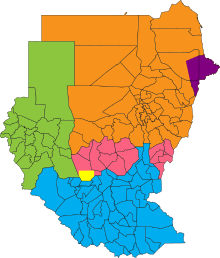Naivasha Agreement
The Comprehensive Peace Agreement for the Sudan ( English Comprehensive Peace Agreement CPA), often as a Comprehensive Peace Agreement ( Naivasha Agreement referred to) is a package of several agreements between the South Sudanese rebel SPLM / A ( Sudan Liberation Movement / Army ) and the Sudanese government, the last part of which was closed in January 2005.
The Naivasha Agreement ended the civil war for independence in South Sudan . It granted South Sudan autonomy within Sudan and a share of the revenues from the oil reserves in its area. It also laid the foundation for the independence referendum in South Sudan in 2011 , which was followed by South Sudan's independence on July 9, 2011.
The partial agreements
The Naivasha Agreement consists of the following parts:
- Machakos Convention : signed in Machakos , Kenya , on July 20, 2002 on general questions of government formation and self-government
- Convention on Security: signed in Naivasha , Kenya, on September 25, 2003
- Treasury Sharing Convention: signed in Naivasha, Kenya on January 7, 2004
- Power-Sharing Convention: signed in Naivasha, Kenya, on May 26, 2004
- Convention on Conflict Resolution in South Kordofan / Nuba Mountains and Blue Nile : signed Naivasha, Kenya, on May 26, 2004
- Abyei Conflict Resolution Convention : signed in Naivasha, Kenya, on May 26, 2004
- Armistice and security agreement: signed in Naivasha on October 30, 2004, also contains provisions for the further negotiation process
- and, most recently, a formal decision-making agreement of January 9, 2005, which summarizes the conventions and defines how they are to be implemented.
Implementation and problems
While SPLM leader John Garang had advocated reforms within a unified Sudan, after his death in 2005, shortly after the Naivasha Agreement was signed, there were hardly any supporters of such a scenario, the SPLM was now largely for the independence of the South.
On October 11, 2007, the SPLM temporarily withdrew from the Government of National Unity GoNU because the government had broken the peace agreement. It was pointed out in particular that 15,000 North Sudanese soldiers were still standing in the South Sudanese oil fields and that the provisions relating to the Abyei area had not been implemented. Observers cited international focus on the conflict in Darfur as the reason for the shortcomings. On December 13, 2007, the SPLM re-entered the unity government, with the presidency changing between Juba and Khartoum every three months . The northern Sudanese troops finally withdrew completely from the south by January 8, 2008.
In May 2008, the worst fighting between northern and southern Sudanese troops since the Naivasha Agreement broke out in Abyei . There were also several smaller clashes between northern and southern troops, but these did not develop into open war.
The original rationale of the Naivasha Agreement, " making unity attractive ", has hardly been implemented.
The independence referendum in South Sudan in 2011 took place according to plan and resulted in a majority of over 99% in favor of independence. The independence of South Sudan was declared on July 9, 2011 and also recognized by North Sudan. However, the separate referendum for Abyei was postponed indefinitely as there was no agreement on who would be eligible to vote. The referendums in South Kordofan and the Blue Nile have not yet been held either.
Individual evidence
- ↑ Gerard Prunier: Brief History of South Sudan, in: Le Monde diplomatique, February 2011 , p. 10
- ^ Sudan: Southern pull-out threatens peace deal. IRIN, October 11, 2007
- ^ Sudan to have shuttle government. BBC News, December 13, 2007
- ↑ North Sudan troops complete southern withdrawal: ex-rebels. AFP, January 8, 2008 ( Memento from September 25, 2010 in the Internet Archive )
- ↑ International Crisis Group: Sudan: Regional Perspectives on the Prospect of Southern Independence ( Memento of August 7, 2011 in the Internet Archive ), 2010
Web links
- The Comprehensive Peace Agreement between The Government of The Republic of The Sudan and The Sudan People's Liberation Movement / Sudan People's Liberation Army. ReliefWeb, January 9, 2005
- Comprehensive Peace Agreement. United Nations Mission in Sudan
- Sudan: Human Rights Accountability Must Be Part of North-South Peace Agreement. Human Rights Watch, November 2004
- Denis M. Tull: Sudan after the Naivasha Peace Agreement: No Champagne Yet. German Institute for International and Security Affairs, February 3, 2005
- The Khartoum-SPLM Agreement: Sudan's Uncertain Peace. International Crisis Group, July 25, 2005
- Sudan's Comprehensive Peace Agreement: The Long Road Ahead. International Crisis Group, March 31, 2006
- Sudan's Comprehensive Peace Agreement: Beyond the Crisis. International Crisis Group, March 13, 2008

